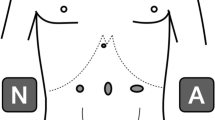Abstract
Background
Boerhaave’s syndrome requires urgent thoracotomy, laparotomy, or both for esophageal repair and pleuromediastinal debridement. Minimally invasive techniques may be suitable alternatives.
Material and methods
Over a period of 12 months, three patients with spontaneous esophageal perforations after forceful vomiting were treated by a combination of minimally invasive techniques including laparoscopy, thoracoscopy, mediastinoscopy, and endoscopic stenting.
Results
Esophageal repair was performed transhiatally via laparoscopy using primary suture, primary suture reinforced by a fundic patch, and fundic patch alone in one patient each. One patient had a second perforation of the proximal esophagus, which was sutured through a cervical incision. This patient successfully underwent secondary endoscopic stenting for a persistent esophageal fistula. Mediastinal debridement was performed transhiatally and also by means of a mediastinoscope introduced via the cervical incision in one patient. One patient required secondary thoracoscopic debridement of a pleural empyema but died of sepsis after 1 month. The two other patients recovered and were discharged from the hospital after 2 and 8 weeks, respectively.
Conlusions
Boerhaave’s syndrome is amenable to minimally invasive techniques. Avoidance of a formal thoracotomy with its resulting morbidity could be of considerable benefit to these critically ill patients.
Similar content being viewed by others
References
Dumonceau JM, Cremer M, Lalmand B, Deviere J (2000) Treatment of Boerhaave’s syndrome using the Ultraflex self-expandable stent. Gastrointest Endosc 51: 773–774
Dumonceau JM, Deviere J, Capello M, Van Gossum A, Cremer M (1996) Endoscopic treatment of Boerhaave’s syndrome. Gastrointest Endosc 44: 477–479
Eubanks PJ, Nguyen D, Procaccino F, Eysselein VE, Klein SR (1999) Case of Boerhaave’s syndrome successfully treated with a self-expandable metallic stent. Gastrointest Endosc 49: 780–783
Fry SW, Fleischer DE (1997) Management of a refractory benign esophageal stricture with a new biodegradable stent. Gastrointest Endosc 45: 179–182
Henderson JAM, Peloquin AJM (1989) Boerhaave revisited: Spontaneous esophageal perforation as a diagnostic masquerader. Am J Med 86: 559–567
Jones II WG, Ginsberg RJ (1992) Esophageal perforation: a continuing challenge. Ann Thorac Surg 53: 534–543
Lawrence DR, Ohri SK, Moxon RE, Townsend ER, Fountain SW (1997) Thoracoscopic debridement of empyema thoracis. Ann Thorac Surg 64: 1448–1450
Lawrence DR, Ohri SK, Moxon RE, Townsend ER, Fountain SW (1999) Primary esophageal repair for Boerhaave’s syndrome. Ann Thorac Surg 67: 818–820
Sandha GS, Marcon NE (1999) Expandable metal stents for benign esophageal obstruction. Gastrointest Endosc Clin North Am 9: 437–446
Skinner DB, Little AG, DeMeester TR (1988) Management of esophageal perforation. Am J Surg 139: 760–764
Author information
Authors and Affiliations
Additional information
Online publication: 23 May 2002
Rights and permissions
About this article
Cite this article
Landen, S., El Nakadi, I. Minimally invasive approach to Boerhaave’s syndrome. Surg Endosc 16, 1354–1357 (2002). https://doi.org/10.1007/s00464-001-9185-4
Received:
Accepted:
Issue Date:
DOI: https://doi.org/10.1007/s00464-001-9185-4




